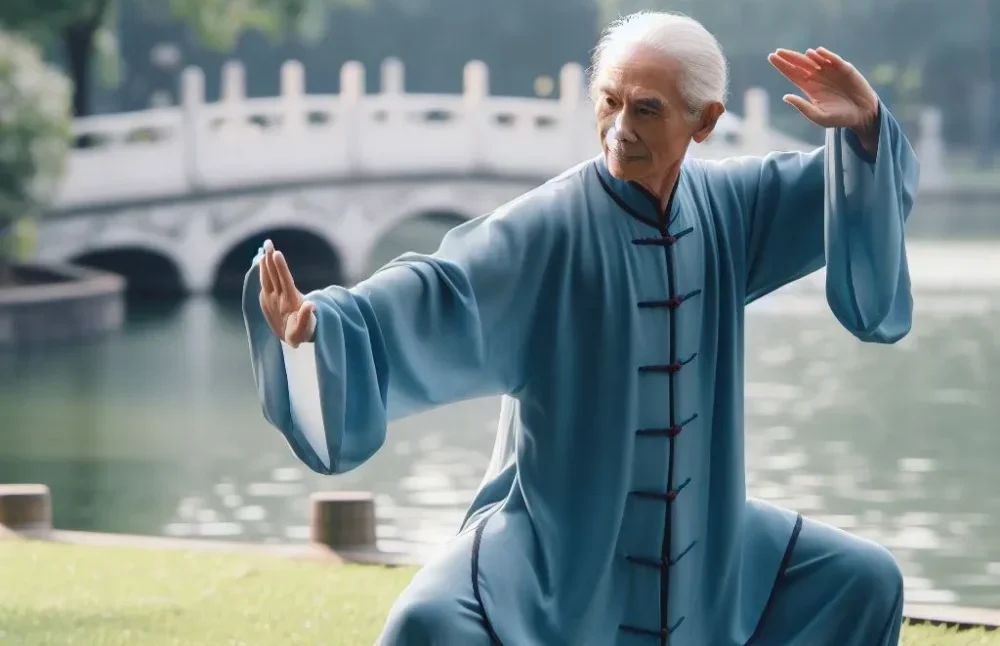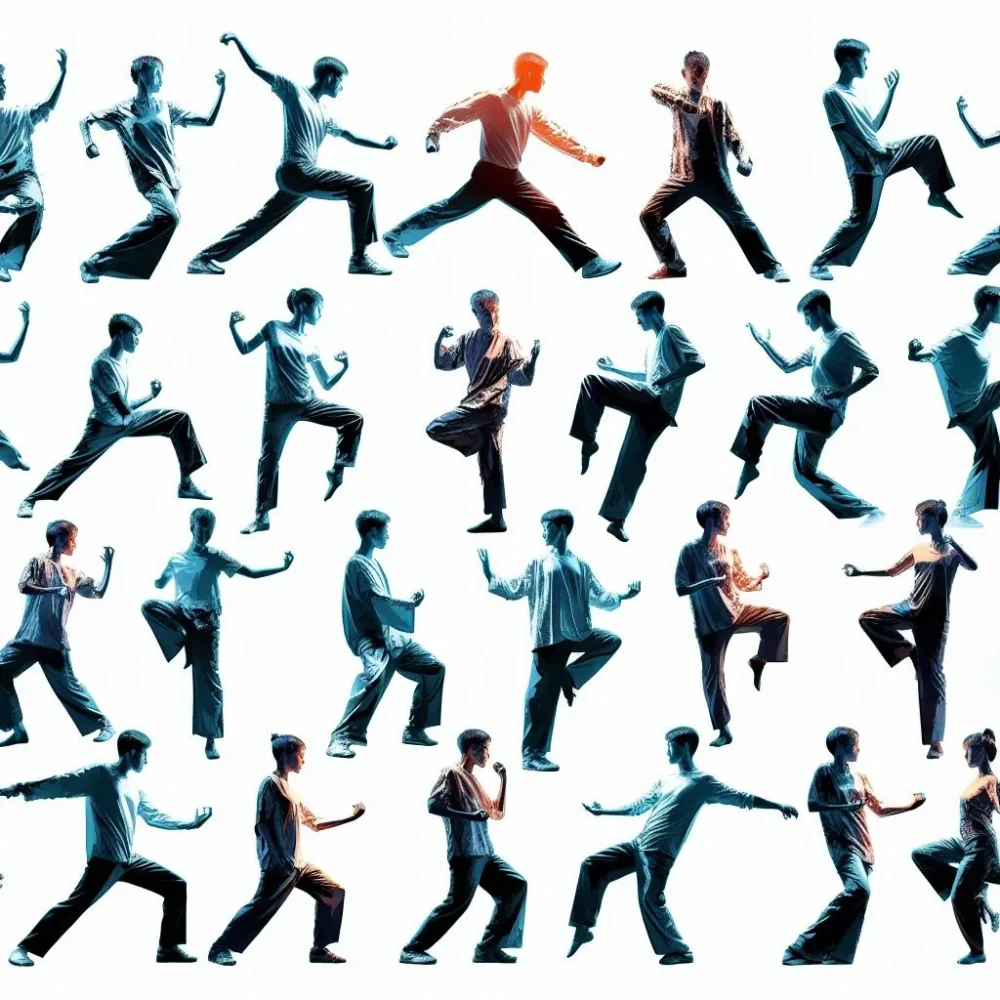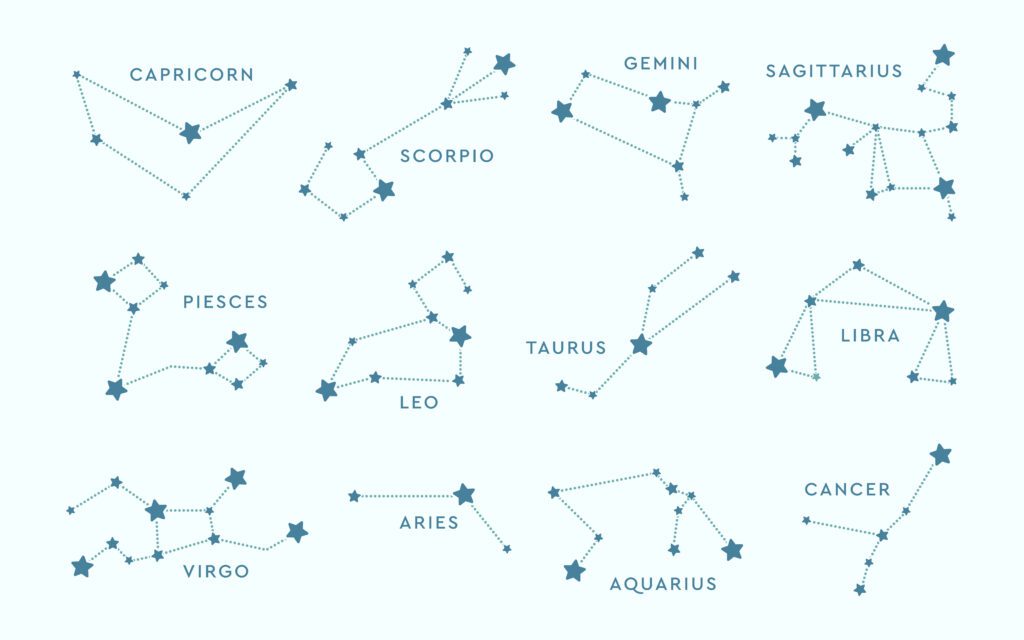
Tai chi is a form of martial arts that has its base in China and has been practiced for centuries. It is also known as Tai Chi Chuan, meaning “Supreme Ultimate Fist” or “Grand Ultimate Boxing”.
It involves simple physical movements, breathing techniques, and mental meditation to achieve a state of harmony between your body and mind. It is often described as “dynamic meditation” or “moving yoga”.
Table of Contents
History of Tai Chi
It has a rich history that dates back to the 12th century when a Taoist monk named Zhang Sanfeng created the original style of Tai Chi based on his observations of nature and animals. He was inspired by the concept of yin and yang.
Yin and yang are opposing forces that balance each other in the universe. Tai Chi aims to balance the yin and yang energies within the body and develop qi. Qi is the vital life force that flows through all living things.
As time passed, different styles and schools of Tai Chi emerged, each with its own characteristics and emphasis. Some of the most popular styles are Yang, Chen, Wu, Sun and Hao.
Each style has its own form. A form is a sequence of movements that have specific names and meanings. Some forms are short and simple, while others are long and complex.
Some forms are slow and graceful, while others are fast and powerful. Some forms are performed alone while others are performed with a partner or group.
Benefits of Tai Chi
Tai chi is not only a martial art but also a health-promoting exercise that can benefit people of all ages. Here are 10 benefits of Tai Chi that are supported by scientific research:
1. It Improves Balance and Helps Parkinson’s Disease.
Tai chi may help older adults prevent falls and improve stability by increasing their balance control and flexibility.
A 2012 review of 159 randomized controlled trials involving more than 79,000 participants found that it reduced the risk of falls by 20% compared with other interventions.
A 2012 trial of 195 older adults with Parkinson’s disease showed that it improved their balance more than resistance training or stretching.
2. It helps reduce pain.
Tai chi can help relieve chronic pain associated with conditions like osteoarthritis and fibromyalgia by relaxing muscles and joints and improving blood circulation.
A 2013 meta-analysis of seven trials involving 348 participants suffering from knee osteoarthritis found that it reduced pain and stiffness and improved physical function compared with other treatments.
A 2018 randomized controlled trial of 226 participants with fibromyalgia found that it reduced pain intensity and improved quality of life compared with aerobic exercise.
3. It improves your mood.
Tai chi can help improve psychological well-being by reducing stress, anxiety, and depression, and increasing self-esteem and happiness.
A 2010 meta-analysis of 40 studies involving 3,817 participants showed that it had positive effects on mood, anxiety, depression, self-esteem, and quality of life.
4. Improve your sleep quality.
Tai chi may help improve sleep quality by promoting relaxation and regulating circadian rhythms.
A 2008 meta-analysis of nine studies involving 488 participants found that it improved sleep quality more than no treatment or low-impact exercise.
5. Strengthen your immune system.
Tai chi may help boost the immune system by increasing the production and function of immune cells and reducing inflammation.
A 2007 randomized controlled trial of 112 healthy older adults found that it increased antibody levels against varicella-zoster virus (the cause of shingles) more than a health education intervention.
6. It reduces blood pressure.
Tai chi may help lower blood pressure by relaxing blood vessels and improving heart function.
A 2008 meta-analysis of 26 studies involving 1,641 participants found that it reduced systolic blood pressure (top number) by an average of 15 mmHg and diastolic blood pressure (bottom number) by an average of 8 mmHg, compared with no treatment or others. reduced. Exercise.
7. It improves fitness.
Tai chi can help improve cardiovascular fitness, muscle strength, endurance, and flexibility.
A 2015 systematic review of 33 studies involving 2,813 participants found that it improved aerobic capacity, muscle strength, and endurance compared to no exercise.
Additionally, a 2016 meta-analysis of 18 studies involving 1,584 participants found that it improved flexibility more than no exercise or other exercises.
8. It increases brain function.
Tai chi may help improve cognitive function, memory, attention, and learning. A 2018 randomized controlled trial of 120 healthy older adults found that it improved memory, attention, and learning more than social interaction or no intervention.
9. It reduces stress.
Tai chi can help reduce stress by inducing a relaxation response and reducing levels of stress hormones such as cortisol. A 2017 randomized controlled trial of 50 healthy college students found that it reduced cortisol levels more than a control group.
Related: How to Overcome Depression with and without Medication?
10. It increases happiness.
Tai chi can help increase happiness by increasing positive emotions and decreasing negative emotions. A 2013 randomized controlled trial of 152 older adults with depression found that it increased happiness and life satisfaction more than a wait-list control group.
How long does it take to learn Tai Chi?
It takes 3 to 6 months to learn the basic movements of Tai Chi.
Also, the answer depends on your goals, capabilities, and preferences. Some people learn it for health, some for martial arts, and some for spirituality.
How to start Tai Chi as a beginner?

If you’re interested in learning Tai Chi and want to enjoy its benefits, here are some tips for beginners:
1. The first step is to choose the best Tai Chi style for your goals and preferences.
There are many different styles of Tai Chi, each with its own characteristics and emphasis. Some styles are more suited to health and wellness, while others focus more on martial arts and self-defense. Some styles are more complex and challenging, while others are more simple and easy. Do some research on different styles and find the one that suits you best.
2. Find a qualified Tai Chi instructor or master:
Someone who has extensive knowledge and experience of the art can guide you through the correct techniques and principles. Look for a certified instructor or master who has a good reputation and teaches in the style you like. You can also look for online reviews, testimonials, or referrals from other students or practitioners.
3. Observe a class or two before joining.
Watching a Tai Chi class can help you become familiar with the movements, movements, and atmosphere of the practice. You can also see how the instructor interacts with students and how students respond to instruction. This can help you decide if the class is a good fit for you and whether you feel comfortable attending.
4. Wear comfortable clothes and shoes.
Tai chi requires you to move your body in different ways so you will need to wear clothing that allows you to move freely and comfortably. Avoid tight-fitting clothing or clothing that restricts your breathing or circulation. You also need to wear shoes that are flat, flexible, and supportive. Avoid shoes that are too heavy as they can hinder your movement.
5. Start with the basics.
Tai Chi is a complex art that involves many aspects such as posture, breathing, movement, coordination, balance, awareness, and energy. It can be overwhelming to learn everything at once, so it’s best to start with the basics and gradually progress to more advanced levels.
You should first focus on learning the basic principles and techniques, such as:
- How to stand properly.
- How to breathe deeply and naturally.
- How to relax your muscles and joints.
- How to move smoothly and gracefully.
- How to align your body and mind.
- And How to feel your qi flow.
6. Practice regularly and consistently.
Tai chi is not something you can learn in a few sessions or weeks. It takes time and practice to develop your skills and abilities. The more you practice, the more you will improve and benefit from Tai Chi.
Have you not heard the well-known saying, “Practice makes perfect“?
You should practice at least 3 times a week for about 20 to 30 minutes each time. You can practice at home, in the park, or any place where you feel comfortable and calm.

7. Be patient and enjoy the process.
Tai Chi is not a competition or race. You don’t need to compare yourself with others or rush to achieve certain goals. You have to be patient with yourself and enjoy the process of learning and practicing.
Haven’t you heard the famous quote “Patience is the key to success”?
Appreciate every moment of your practice and every improvement you make. Always celebrate your achievements and learn from the mistakes you have made so you don’t repeat them in the future.
It is a wonderful art that can enrich your life in many ways. It can help you improve your physical health, mental well-being, emotional balance, and spiritual growth. It can also connect you to nature, yourself, and others.
What are some common mistakes people make when learning Tai Chi?
Learning it can be fun and rewarding, but also challenging and frustrating. Here are some common mistakes that people make and how to avoid them:
1. You’re working out too hard or too quickly.
It should be practiced slowly and gradually while relaxing the muscles and joints. It helps the flow of energy (qi) in the body and mind. Exercising too fast or too hard can lead to strain, fatigue, and injury.
2. Comparing yourself to others.
Tai chi is an individual journey that is different for everyone. Comparing yourself to others can lead to dissatisfaction, frustration, and discouragement. This can also become a hindrance to your progress and development. To practice correctly, focus on your own experience and improvement rather than anyone else’s.
3. Giving up too early or too late.
Tai Chi is a lifelong pursuit that requires commitment and patience. Giving up too early or too late can keep you from reaching your full potential and enjoying its benefits.
Giving up too early can mean missing out on the rewards of hard work and dedication.
Giving up too late can mean wasting time and energy on something that is not suitable or beneficial for you. To practice correctly, be realistic about your goals and abilities and make adjustments accordingly.
The Bottom-line
To master Tai Chi, you need to practice regularly and consistently for years or even decades. It is not only a physical exercise but also a mental and spiritual discipline that requires constant improvement. Tai Chi practitioners say that there is no end to learning it, as there is always something new to learn.



Nice post. I learn something totally new and challenging on websites
Wow, this blogger is seriously impressive!
I would want to express my gratitude to the owner of this website for providing readers like me with such a wonderful article to read here at this location.